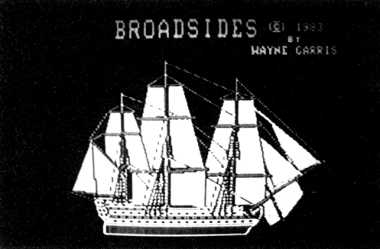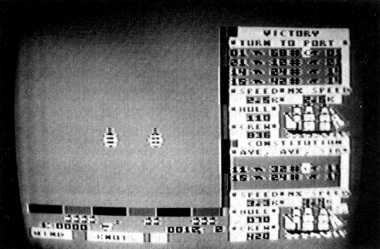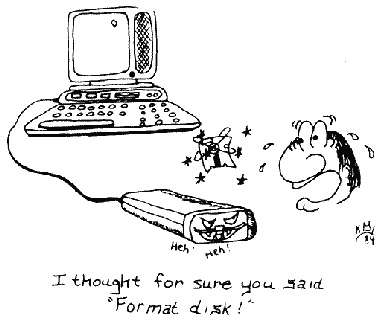Strategy Zone
by Bob Cockroft
by Bob Cockroft

Broadsides
SSI
SSI
Batten down the hatches, turn into the wind and prepare for high seas adventure with SSI's new game, Broadsides. Explore the previously unchartered waters of early naval warfare with a giant square rigger of the past. As a captain of one of these sea steeds it is your goal to sink your opponent ship. This is not always easy in that a number of factors inhibit your performance. Wind direction, the speed of your ship, gun size and range must be taken into consideration in order to win any battle. Because this game uses real time, commands will need to be made quickly and accurately. The play progresses quickly enough so that all tedious routes that many strategy games have are avoided.
Being not only a strategy game and not only an arcade game, Broadsides is an enjoyable combination of both.

In one sense, this game is a fairly interesting tactical simulation of naval warfare. The optimal strategy is simple and pragmatic. Sail directly in front of or behind your opponent so that his guns cannot fire on you. Positioning yourself in this famous `T' formation usually means the difference between victory and defeat.
In another sense, Broadsides is an arcade game. Because the ship's controls can be made to react so quickly, the captain must continuously give orders. The ship moves and fires in much the same way as any shoot-em up game I have played. But one of this game's most interesting aspects is its 'arcade' option. This option eliminates all of the detailed and more tactically orientated commands. The result is a more arcade like and playable game.

Broadsides has been designed so that it does not become predictable and monotonous after playing it only a couple of times. With several different scenarios, each having its own particular ships, a number of battle situations can be created. In addition, there is an option that allows the captain to design his own ship. Complete with name, gun size and range, a captain is able to build a vessel to suit he own particular style of warfare. However, every design has its limitations. The more and the heavier the guns your ship contains, the slower it will move. I found this option particularly exciting. It adds a dimension that many other games lack. When players are able to design their own ships, they can express their own preferences. In addition, players are able to create a ship that best suits there own strategies.
This game contains some interesting graphics. The main tactical screen displays a horizontal view of your ship. This view will display any visible damage you have sustained. By allowing you to see what condition your vessel is in, this game creates a more realistic simulation.
Unfortunately, Broadsides does have some shortcomings. The most significant of these is the boarding sequence. After the two combatting ships have pulled along side of each other, a new screen will appear and the crews will begin hand to hand fighting. Unfortunately, the captain has little control over what happens after this. He becomes more of a spectator than an participant. In addition, this sequence often lasts too long. As a result, it becomes uninteresting and often monotonous. The second shortcoming is the lack of speed at which the game restarts after a battle has been completed. It seems as though the entire program needs to be reLOADed from the disk in order to play the game again. Although this is only a minor problem, it is sometimes bothersome, particularly if you usually have short battles.
Broadsides is a fairly good blend of tactical naval warfare with fast arcade action. Although the boarding sequence is inadequate, the remainder of the game is well designed. Because the play can be made to progress so quickly, Broadsides is interesting even for to those who prefer less involved games.
50
Mission Crush
SSI
SSI
50 Mission Crush, the new game from SSI, puts you at the controls of a B-17 Flying Fortress during World War II. Continental Europe has been over-run by the German army. Using the resources of the occupied countries, Germany has been able to increase its production. As a member of the Allies strategic bombing force you will have the job destroying enemy installations. Sub pens, railroad lines, factories and air fields must be systematically eliminated. Being based in England, you must be able to navigate the channel and identify your target in continental Europe. This, however, is not a simple task. Precise calculations must be made in order to have both the maximum bomb load and enough fuel to reach and to return from the target. Although your bomber can be overloaded, the probability of crashing is increased. Once you have crossed the English channel, German flak will begin to pound the sky and enemy aircraft will begin to strafe your bomber. Much luck and skill is needed in order to complete your 50 assigned, missions.
50 Mission Crush is a fairly good game. The idea of having a role playing game for a B-17 crew is both revolutionary and exciting. It is not often that you see such an old concept as a role playing game take on a new and refreshing theme. There is much potential for games of this type. Unfortunately, 50 Mission Crush does not take complete advantage of this. Although the graphics for the map of northern Europe are acceptable, the take-off and landing displays are inadequate. A more creative landing routine is needed for a better simulation.
50 Mission Crush does not have the time consuming and sometimes boring formalities of some of the more complex games. The game play is quite fast and does not give you time to loose interest. Although it does not contain fantastic graphic routines, 50 Mission Crush is a little addicting. Maybe it's because of the challenge to reach your target, or the chance to imagine what it would have been like to have flown on one of these bombers, that I just seem to play this game again and again.

Being an introductory role playing game, its design is simple and straightforward - drop your bombs on the target and return. There are not as many strategic options as in other games. Decisions are made in the typical A or B structure. Like a fork in the road, your decision can take only one of two routes. Future decisions are not affected by what you have chosen in the past. The result is a simple, fast moving game that does not require a lot of thought. There is more of a `go for it and lets see what happens' philosophy than of a strategic theme. AS proven by 50 Mission Crush, this is not necessarily bad.
The damage reports add an interesting dimension to the game. The computer has a long list of potential problems to choose from and will use one of them to display what has been damaged after being hit by enemy fire. Each problem reduces your aircraft's ability to function in some capacity. For example, a hit to the fuel tank will cause leakage, or a hit to the controls will make landing difficult. Eliminating many of its original functions, repetitive damage will cripple your aircraft.
50 Mission Crush provides excitement with a scenario found in few other games. Because the game play is simple and fast, many people who have never considered role playing games before may enjoy the program. Yet, in another sense, the 50 Mission Crush is confining. Although it is addictive, this program does not explore the B-17 scenario to its potential. It lacks the depth needed to make a good game a great game. Despite some shortcomings, I have enjoyed playing 50 Mission Crush and would recommend it to those who prefer to avoid complex games.
